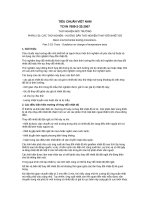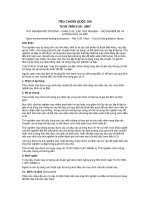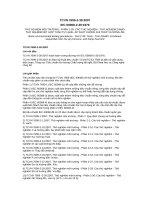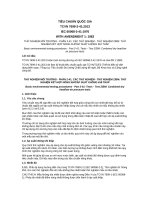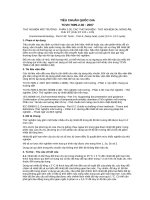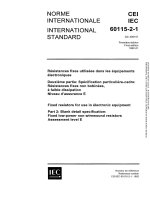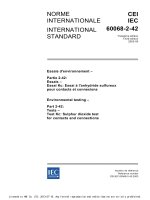Iec 60068 2 41 1976 scan
Bạn đang xem bản rút gọn của tài liệu. Xem và tải ngay bản đầy đủ của tài liệu tại đây (825.98 KB, 24 trang )
NORME
INTERNATIONALE
INTERNATIONAL
STANDARD
CEI
IEC
68-2-41
Première édition
First edition
1976-01
Deuxième partie: Essais
Essai Z/BM: Essais combinés chaleur sèche/basse
pression atmosphérique
Basic environmental testing procedures
Part 2: Tests
Test Z/BM: Combined dry heat/low air pressure tests
IEC•
Numéro de référence
Reference number
CEI/IEC 68-2-41: 1976
LICENSED TO MECON Limited. - RANCHI/BANGALORE
FOR INTERNAL USE AT THIS LOCATION ONLY, SUPPLIED BY BOOK SUPPLY BUREAU.
Essais fondamentaux climatiques
et de robustesse mécanique
Numbering
Depuis le 1er janvier 1997, les publications de la CEI
sont numérotées à partir de 60000.
As from 1 January 1997 all IEC publications are
issued with a designation in the 60000 series.
Publications consolidées
Consolidated publications
Les versions consolidées de certaines publications de
la CEI incorporant les amendements sont disponibles.
Par exemple, les numéros d'édition 1.0, 1.1 et 1.2
indiquent respectivement la publication de base, la
publication de base incorporant l'amendement 1, et la
publication de base incorporant les amendements 1
et 2.
Consolidated versions of some IEC publications
including amendments are available. For example,
edition numbers 1.0, 1.1 and 1.2 refer, respectively, to
the base publication, the base publication
incorporating amendment 1 and the base publication
incorporating amendments 1 and 2.
Validité de la présente publication
Validity of this publication
Le contenu technique des publications de la CEI est
constamment revu par la CEI afin qu'il reflète l'état
actuel de la technique.
The technical content of IEC publications is kept under
constant review by the IEC, thus ensuring that the
content reflects current technology.
Des renseignements relatifs à la date de
reconfirmation de la publication sont disponibles dans
le Catalogue de la CEI.
Information relating to the date of the reconfirmation of
the publication is available in the IEC catalogue.
Les renseignements relatifs à des questions à l'étude et
des travaux en cours entrepris par le comité technique
qui a établi cette publication, ainsi que la liste des
publications établies, se trouvent dans les documents cidessous:
Information on the subjects under consideration and
work in progress undertaken by the technical
committee which has prepared this publication, as well
as the list of publications issued, is to be found at the
following IEC sources:
ã
ôSite webằ de la CEI*
ã
IEC web site*
•
Catalogue des publications de la CEI
Publié annuellement et mis à jour régulièrement
(Catalogue en ligne)*
•
Catalogue of IEC publications
Published yearly with regular updates
(On-line catalogue)*
ã
Bulletin de la CEI
Disponible la fois au ôsite web» de la CEI* et
comme périodique imprimé
•
IEC Bulletin
Available both at the IEC web site* and as a
printed periodical
Terminologie, symboles graphiques
et littéraux
Terminology, graphical and letter
symbols
En ce qui concerne la terminologie générale, le lecteur
se reportera à la CEI 60050: Vocabulaire Électrotechnique International (VEI).
For general terminology, readers are referred to
IEC 60050: International Electrotechnical Vocabulary
(IEV).
Pour les symboles graphiques, les symboles littéraux
et les signes d'usage général approuvés par la CEI, le
lecteur consultera la CEI 60027: Symboles littéraux à
utiliser en électrotechnique, la CEI 60417: Symboles
graphiques utilisables sur le matériel. Index, relevé et
compilation des feuilles individuelles, et la CEI 60617:
Symboles graphiques pour schémas.
For graphical symbols, and letter symbols and signs
approved by the IEC for general use, readers are
referred to publications IEC 60027: Letter symbols to
be used in electrical technology, IEC 60417: Graphical
symbols for use on equipment. Index, survey and
compilation of the single sheets and IEC 60617:
Graphical symbols for diagrams.
* Voir adresse «site web» sur la page de titre.
* See web site address on title page.
LICENSED TO MECON Limited. - RANCHI/BANGALORE
FOR INTERNAL USE AT THIS LOCATION ONLY, SUPPLIED BY BOOK SUPPLY BUREAU.
Numéros des publications
NORME
INTERNATIONALE
INTERNATIONAL
STAN DARD
CEI
IEC
68-2-41
Première édition
First edition
1976-01
Deuxième partie: Essais
Essai Z/BM: Essais combinés chaleur sèche/basse
pression atmosphérique
Basic environmental testing procedures
Part 2: Tests
Test Z/BM: Combined dry heat/low air pressure tests
© CEI 1976 Droits de reproduction réservés — Copyright - all rights reserved
Aucune partie de cette publication ne peut être reproduite ni
utilisée sous quelque forme que ce soit et par aucun procédé,
électronique ou mécanique, y compris la photocopie et les
microfilms, sans l'accord écrit de l'éditeur.
No part of this publication may be reproduced or utilized
in any form or by any means, electronic or mechanical,
including photocopying and microfilm, without permission
in writing from the publisher
Bureau central de la Commission Electrotechnique Internationale 3, rue de Varembé Genève Suisse
IEC
•
Commission Electrotechnique Internationale CODE PRIX
International Electrotechnical Commission PRICE CODE
MeniayHapogHae 3neKrporexHHVecnaa Hot.wiccua
Pour prix, voir catalogue en vigueur
For price, see current catalogue
LICENSED TO MECON Limited. - RANCHI/BANGALORE
FOR INTERNAL USE AT THIS LOCATION ONLY, SUPPLIED BY BOOK SUPPLY BUREAU.
Essais fondamentaux climatiques
et de robustesse mécanique
SOMMAIRE
Pages
PRÉAMBULE
4
PRÉFACE
4
Articles
1.
Introduction
1.1 Généralités
6
1.2 Basse pression atmosphérique
6
1.3 Température
6
6
8
3. Description générale
8
2. Objet
4. Description de l'appareillage d'essai
4.1 Chambre d'essai
8
4.2 Montage
8
5. Sévérités
5.1 Généralités
8
5.2 Association préférentielle de valeurs de température, de pression atmosphérique et de durée
8
6. Préconditionnement
10
10
7. Mesures initiales
8. Epreuve
8.1 Généralités
10
8.2 Méthode d'essai d'un spécimen dissipant de l'énergie sans refroidissement artificiel du spécimen
et d'un spécimen ne dissipant pas d'énergie
10
8.3 Précautions à prendre lorsque les spécimens ont un système de refroidissement artificiel . .
12
9. Mesures intermédiaires
10. Reprise
12
11. Mesures finales
12. Renseignements que doit fournir la spécification particulière
FIGURES
12
12
14
16-18
LICENSED TO MECON Limited. - RANCHI/BANGALORE
FOR INTERNAL USE AT THIS LOCATION ONLY, SUPPLIED BY BOOK SUPPLY BUREAU.
1.4 Documents de référence
CONTENTS
Page
5
FOREWORD
5
PREFACE
Clause
1. Introduction
7
1.2 Low air pressure
7
1.3 Temperature
7
1.4 Related documents
7
2. Object
9
3. General description
9
4.1 Test chamber
9
4.2 Mounting
9
5.1 General
9
5.2 Preferred combinations of temperature, air pressure and duration
9
6. Preconditioning
11
7. Initial measurements
11
11
4. Description of test apparatus
5. Severities
8. Conditioning
8.1 General
8.2 Procedure for heat-dissipating specimen without artificial cooling of the specimen and for non-heat
dissipating specimen
8.3 Precautions when testing specimens with artificial cooling
11
13
13
10. Recovery
13
11. Final measurements
13
12. Information to be given in the relevant specification
15
9. Intermediate measurements
FIGURES
17-19
LICENSED TO MECON Limited. - RANCHI/BANGALORE
FOR INTERNAL USE AT THIS LOCATION ONLY, SUPPLIED BY BOOK SUPPLY BUREAU.
1.1 General
4
COMMISSION ÉLECTROTECHNIQUE INTERNATIONALE
ESSAIS FONDAMENTAUX CLIMATIQUES
ET DE ROBUSTESSE MÉCANIQUE
Deuxième partie : Essais — Essai Z /BM :
Essais combinés chaleur sèche/basse pression atmosphérique
PRÉAMBULE
2) Ces décisions constituent des recommandations internationales et sont agréées comme telles par les Comités nationaux.
3) Dans le but d'encourager l'unification internationale, la CEI exprime le voeu que tous les Comités nationaux adoptent dans leurs
règles nationales le texte de la recommandation de la CEI, dans la mesure où les conditions nationales le permettent. Toute
divergence entre la recommandation de la CEI et la règle nationale correspondante doit, dans la mesure du possible, être indiquée
en termes clairs dans cette dernière.
PRÉFACE
La présente publication a été établie par le Sous-Comité 50B: Essais climatiques, du Comité d'Etudes N o 50 de
la CEI: Essais climatiques et mécaniques.
Un premier projet a été examiné à la réunion de Munich en 1973. Après cette réunion, un document Secrétariat
a été diffusé aux Comités nationaux selon la Procédure Accélérée, puis soumis pour approbation suivant la Règle
des Six Mois sous la forme d'un document 50B(Bureau Central)180 en septembre 1974.
Les pays suivants se sont prononcés explicitement en faveur de la publication:
Afrique du Sud (République d')
Allemagne
Australie
Autriche
Belgique
Canada
Danemark
Espagne
France
Hongrie
Norvège
Pays-Bas
Pologne
Portugal
Royaume-Uni
Suède
Suisse
Tchécoslovaquie
Turquie
Union des Républiques Socialistes Soviétiques
LICENSED TO MECON Limited. - RANCHI/BANGALORE
FOR INTERNAL USE AT THIS LOCATION ONLY, SUPPLIED BY BOOK SUPPLY BUREAU.
1) Les décisions ou accords officiels de la CEI en ce qui concerne les questions techniques, préparés par des Comités d'Etudes où sont
représentés tous les Comités nationaux s'intéressant à ces questions, expriment dans la plus grande mesure possible un accord
international sur les sujets examinés.
INTERNATIONAL ELECTROTECHNICAL COMMISSION
BASIC ENVIRONMENTAL TESTING PROCEDURES
Part 2: Tests — Test Z/BM:
Combined dry heat/low air pressure tests
FOREWORD
2) They have the form of recommendations for international use and they are accepted by the National Committees in that sense.
3) In order to promote international unification, the IEC expresses the wish that all National Committees should adopt the text of
the IEC recommendation for their national rules in so far as national conditions will permit. Any divergence between the IEC
recommendation and the corresponding national rules should, as far as possible, be clearly indicated in the latter.
PREFACE
This publication has been prepared by Sub-Committee 50B, Climatic Tests, of IEC Technical Committee No. 50,
Environmental Testing.
A first draft was discussed at the meeting held in Munich in 1973. As a result of this meeting, a Secretariat draft
was submitted to the National Committees under the Accelerated Procedure and submitted for approval under the
Six Months' Rule as Document 50B(Central Office)180 in September 1974.
The following countries voted explicitly in favour of publication:
Australia
Austria
Belgium
Canada
Czechoslovakia
Denmark
France
Germany
Hungary
Netherlands
Norway
Poland
Portugal
South Africa (Republic of)
Spain
Sweden
Switzerland
Turkey
Union of Soviet Socialist Republics
United Kingdom
LICENSED TO MECON Limited. - RANCHI/BANGALORE
FOR INTERNAL USE AT THIS LOCATION ONLY, SUPPLIED BY BOOK SUPPLY BUREAU.
1) The formal decisions or agreements of the IEC on technical matters, prepared by Technical Committees on which all the National
Committees having a special interest therein are represented, express, as nearly as possible, an international consensus of opinion
on the subjects dealt with.
6
ESSAIS FONDAMENTAUX CLIMATIQUES
ET DE ROBUSTESSE MÉCANIQUE
Deuxième partie : Essais - Essai Z /BM :
Essais combinés chaleur sèche/basse pression atmosphérique
1. Introduction
1.1 Généralités
Le but de cet essai est de déterminer l'aptitude des composants, équipements ou autres articles à être stockés
ou utilisés dans des conditions de température élevée et de basse pression atmosphérique, appliquées simultanément.
L'essai combiné ne devrait normalement être utilisé que dans le cas où les effets des conditions combinées ne
peuvent pas être obtenus en soumettant le spécimen à des conditions séparées. Les méthodes exposées dans cette
publication ne sont applicables qu'aux spécimens qui atteignent la stabilité thermique pendant l'essai.
Dans le cas des spécimens dissipant de l'énergie, cette méthode doit être utilisée seulement pour l'essai d'un
seul spécimen à la fois.
1.2 Basse pression atmosphérique
La méthode d'essai est applicable pour des valeurs de pression atmosphérique supérieures à 10 mbar environ.
Pour des valeurs de pression atmosphérique inférieures, les phénomènes dont il n'a pas été tenu compte dans
l'établissement de la méthode d'essai, deviennent importants.
La relation entre l'altitude, la pression et la température n'a pas été donnée dans cette publication. Ces informations figurent généralement dans les publications spécialisées.
1.3 Température
1.3.1 Les recommandations faites dans l'introduction à la Publication 68-2-2 de la CEI, Essais B: Chaleur sèche,
concernant l'utilisation d'essais pour spécimens ne dissipant pas d'énergie à la place d'essais pour spécimens
dissipant de l'énergie doivent être suivies.
Note. — La définition des spécimens ne' dissipant pas d'énergie est conforme à l'article 4 de la Publication 68-1. La mesure de la température du point le plus chaud ne doit pas être faite à basse pression.
1.3.2 Les spécimens dissipant de l'énergie devraient de préférence être essayés sans circulation forcée d'air, comme
pour les essais B: Chaleur sèche.
1.4 Documents de référence
Publication 68: — Essais fondamentaux climatiques et de robustesse mécanique.
Première partie: Généralités.
Deuxième partie: Essais. Essais B: Chaleur sèche.
Publication 68-2-2:
Publication 68-2-13: Deuxième partie: Essais. Essai M: Basse pression atmosphérique.
Troisième partie: Informations de base. Section un: Essais de froid et de chaleur sèche.
Publication 68-3-1:
Publication 68-1:
Publication 68-3-2:
Troisième partie: Informations de base. Section deux: Essais combinés température/basse
pression atmosphérique.
LICENSED TO MECON Limited. - RANCHI/BANGALORE
FOR INTERNAL USE AT THIS LOCATION ONLY, SUPPLIED BY BOOK SUPPLY BUREAU.
Cette publication décrit les essais combinés chaleur sèche (avec variation lente de la température) et basse pression
atmosphérique pour les spécimens dissipant de l'énergie d'une part et ceux ne dissipant pas d'énergie d'autre part.
7
BASIC ENVIRONMENTAL TESTING PROCEDURES
Part 2: Tests — Test Z/BM:
Combined dry heat/low air pressure tests
1. Introduction
1.1 General
The object of the test is to determine the ability of components or equipments or other articles to be stored and
used under a simultaneous combination of high temperature and low air pressure.
This combined test should normally be used only if the effects of combined environments will not be revealed
by subjecting the specimen to single environments. The procedures given in this publication are limited to the
case of specimens which achieve temperature stability during the test procedure.
In the case of testing heat-dissipating specimens, this procedure applies only to the testing of one specimen at
a time.
1.2 Low air pressure
The test procedure applies to air pressure down to about 10 mbar. At air pressures below 10 mbar, phenomena
not taken into account in the design of this test procedure become important.
The relationship between altitude, pressure and temperature has not been indicated in this publication. Such
data should be obtained from special publications.
1.3 Temperature
1.3.1 The guidance given in the introduction to I E C Publication 68-2-2, Tests B: Dry heat, for the application
of tests for non-heat-dissipating specimens versus tests for heat-dissipating specimens shall apply.
Note. — Non-heat-dissipating specimens are defined as in Clause 4 of Publication 68-1. The measurements of hottest spot temperature
must not be made at reduced pressure.
1.3.2 Heat-dissipating specimens should preferably be tested with no forced air circulation as for Tests B: Dry heat.
1.4 Related documents
Publication 68: — Basic Environmental Testing Procedures.
Part L General.
Publication 68-1:
Part 2: Tests. Tests B: Dry Heat.
Publication 68-2-2:
Publication 68-2-13: Part 2: Tests. Test M: Low Air Pressure.
Part 3: Background Information. Section One: Cold and Dry Heat Tests.
Publication 68-3-1:
Publication 68-3 -2:Part 3: Background Information. Section Two: Combined Temperature/Low Air Pressure
Tests.
LICENSED TO MECON Limited. - RANCHI/BANGALORE
FOR INTERNAL USE AT THIS LOCATION ONLY, SUPPLIED BY BOOK SUPPLY BUREAU.
This publication deals with combined dry heat (with gradual change of temperature) and low air pressure tests
for both heat-dissipating and non-heat-dissipating specimens.
—8—
2.
Objet
L'essai a pour but de mettre en évidence l'aptitude des composants, équipements ou autres articles à être utilisés
ou stockés dans des conditions de température élevée et de basse pression atmosphérique appliquées simultanément.
3.
Description générale
Cet essai consiste en une combinaison des essais Bb ou Bd: Chaleur sèche et de l'essai M: Basse pression
atmosphérique.
Le spécimen est d'abord soumis à l'essai de chaleur sèche avec la sévérité appropriée, suivant les prescriptions
de la spécification particulière. Dans le cas où des conditions de fonctionnement sont prévues, on effectue alors
une vérification pour s'assurer que le spécimen est en état de fonctionner.
4.
Description de l'appareillage d'essai
4.1 Chambre d'essai
La chambre doit permettre le maintien des conditions spécifiées pour l'essai Bb (pour un spécimen ne dissipant
pas d'énergie) ou pour l'essai Bd (pour un spécimen dissipant de l'énergie) et pour l'essai M. Les conditions relatives à la température des parois de la chambre d'essai ne sont pas applicables pendant les périodes de variation
de la pression.
Des précautions doivent être prises pour- éviter la contamination du spécimen en essai provoquée par les dispositifs
auxiliaires et par l'introduction de l'air lorsque la pression est ramenée à la valeur normale.
4.2 Montage
Pour un spécimen dissipant de l'énergie, le montage d'essai doit être conforme aux conditions prescrites pour
l'essai Bd.
5.
Sévérités
5.1 Généralités
Les sévérités définies par la température, la pression atmosphérique et la durée de l'exposition doivent être
prescrites dans la spécification particulière.
Les valeurs de température, de basse pression atmosphérique, de tolérance et de durée doivent être choisies parmi
celles données pour les essais Bb, Bd et M. Des tolérances plus larges sur la température (±3 °C jusqu'à 100 °C
et ±5 °C jusqu'à 200 °C) peuvent être utilisées pour l'essai combiné de chaleur sèche et de basse pression atmosphérique indépendamment des dimensions de la chambre.
La durée de l'exposition doit être décomptée à partir du moment où le spécimen a atteint la stabilité thermique
dans les conditions de basse pression atmosphérique (voir les figures la, page 16, et lb, page 18).
5.2 Association préférentielle de valeurs de température, pression atmosphérique et durée
Pression atmosphérique
Température
85 °C, 155 °C
55 °C, 85 °C, 155 °C
55 °C
55 °C
55 °C
40 °C
44 mbar
150 mbar
300 mbar
533 mbar
700 mbar
600 mbar
Durée
2h
2h
2h
2h, 16h
2h, 16h
2h
LICENSED TO MECON Limited. - RANCHI/BANGALORE
FOR INTERNAL USE AT THIS LOCATION ONLY, SUPPLIED BY BOOK SUPPLY BUREAU.
La température étant maintenue à la valeur prescrite, la pression de l'air dans la chambre est réduite jusqu'à
la valeur appropriée indiquée dans la spécification particulière. Ces conditions sont maintenues pendant la durée
spécifiée. Un diagramme descriptif de la méthode est donné aux figures la, page 16, et lb, page 18.
—9—
2.
Object
To provide a standard test procedure to determine the suitability of components, equipments or other articles
for use and/or storage under a combination of high temperature and low air pressure.
3.
General description
This test is a combination of Tests Bb or Bd: Dry heat, and Test M: Low air pressure.
The specimen is first subjected to the appropriate severity of dry heat as specified in the relevant specification.
In the case of operational tests, a check is then made to ensure that the specimen is capable of operation.
4.
Description of test apparatus
4.1 Test chamber
The chamber shall be capable of maintaining the conditions specified for Test Bb (for non-heat-dissipating
specimen) or Test Bd (for heat-dissipating specimen) and for Test M. The requirement for the chamber wall temperature does not apply during periods of temperature or pressure change.
Care shall be taken to avoid air contamination by ancillary equipment and devices and by the air introduced
when pressure is restored to normal.
4.2 Mounting
For the testing of a heat-dissipating specimen, the mounting of the test specimen shall comply with the requirements of Test Bd.
5.
Severities
5.1 General
The severities, as indicated by temperature, air pressure and duration of exposure, shall be specified in the
relevant specification.
The temperature and low air pressure values, tolerances and durations shall comply with those given 'in Tests Bb
or Bd and M. The wider tolerances on temperature (+3 °C up to 100 °C and +5 °C up to 200 °C) can be accepted
for the combined dry heat/low air pressure test regardless of the size of the chamber.
The duration of exposure shall be measured from the time when temperature stability of the specimen has been
reached under conditions of low air pressure (see Figures la, page 17, and lb, page 19).
5.2 Preferred combinations of temperature, air pressure and duration
Temperature
85 °C, 155 °C
55 °C, 85 °C, 155 °C
55 °C
55 °C
55 °C
40 °C
Air pressure
Duration
44 mbar
150 mbar
300 mbar
533 mbar
700 mbar
600 mbar
2h
2h
2h
2 h, 16 h
2 h, 16 h
2h
LICENSED TO MECON Limited. - RANCHI/BANGALORE
FOR INTERNAL USE AT THIS LOCATION ONLY, SUPPLIED BY BOOK SUPPLY BUREAU.
With the temperature maintained at the prescribed value, the chamber air pressure is then reduced to the appropriate severity as specified in the relevant specification. These conditions are maintained for the specified duration.
Test profiles illustrating the procedure are shown in Figures la, page 17, and lb, page 19.
— 10 —
6.
Préconditionnement
La spécification particulière peut prescrire un préconditionnement.
7.
Mesures initiales
Le spécimen doit être examiné visuellement et soumis aux vérifications électriques et mécaniques prescrites par
la spécification particulière.
8.
Epreuve
8.1 Généralités
Ils doivent être de préférence essayés sans circulation forcée de l'air dans la chambre conformément à l'essai Bd.
Lorsque la chambre utilisée pour l'essai est assez grande pour remplir les conditions spécifiées pour l'essai Bd,
annexe A, et lorsque le chauffage peut seulement être obtenu par une circulation forcée de l'air, la méthode A de
l'essai Bd permettant une circulation de l'air peut être utilisée.
Spécimens ne dissipant pas d'énergie
Ils peuvent être essayés dans une chambre avec ou sans circulation forcée de l'air.
8.2 Méthode d'essai d'un spécimen dissipant de l'énergie sans refroidissement artificiel du spécimen et d'un spécimen
ne dissipant pas d'énergie
8.2.1 La chambre doit être à la température du laboratoire.
Le spécimen étant à la température ambiante du laboratoire doit être introduit dans la chambre, non emballé, sans
application de tension, prêt à être utilisé, dans sa position normale ou selon prescriptions particulières.
Si c'est un spécimen dissipant de l'énergie, il doit être mis en fonctionnement ou soumis aux conditions de dissipation.
8.2.2 La température à l'intérieur de la chambre doit être réglée à la valeur appropriée pour la sévérité prescrite.
Ces conditions sont maintenues pendant une durée suffisante pour permettre au spécimen d'atteindre la stabilité
thermique.
La vitesse de variation de la température dans la chambre ne doit pas dépasser 1 °C par minute, la moyenne étant
effectuée sur une durée inférieure ou égale à 5 minutes.
La température (ambiante) d'essai doit être mesurée comme indiqué dans le paragraphe 4.4.2 de la Publication 68-1
de la CEI.
8.2.3 Pour les essais en fonctionnement seulement:
Le spécimen doit ensuite être soumis à une vérification du fonctionnement conformément à la spécification particulière.
Le spécimen peut rester en fonctionnement ou être mis hors tension selon les prescriptions de la spécification
particulière.
Note. — Un spécimen peut être en fonctionnement ou soumis à des conditions de dissipation sans pour autant avoir une dissipation
telle que l'élévation de sa température oblige à le considérer comme dissipant de l'énergie conformément à la définition du
spécimen dissipant de l'énergie donnée à l'article 4 de la Publication 68-1 de la CEI.
La spécification particulière peut prescrire une autre méthode pour les vérifications à température élevée, sous
pression atmosphérique normale.
LICENSED TO MECON Limited. - RANCHI/BANGALORE
FOR INTERNAL USE AT THIS LOCATION ONLY, SUPPLIED BY BOOK SUPPLY BUREAU.
Spécimens dissipant de l'énergie
— 11 —
6. Preconditioning
The relevant specification may call for preconditioning.
7 . Initial measurements
The specimen shall be visually inspected and electrically and mechanically checked as required by the relevant
specification.
8. Conditioning
8.1 General
These shall preferably be tested without forced air circulation in the chamber according to Test Bd. When the
chamber used for testing is large enough to meet the conditions specified in Test Bd, Appendix A, but heating
of the chamber can only be carried out by circulation of air, the method A with forced air circulation of Test Bd
can be applied.
Non-heat-dissipating specimens
These may be tested in a chamber with or without forced air circulation.
8.2 Procedure for heat-dissipating specimen without artificial cooling of the specimen and for non-heat-dissipating
specimen
8.2.1 The chamber shall be at the temperature of the laboratory.
The specimen at the ambient temperature of the laboratory shall be introduced into the chamber in the unpacked,
switched-off, "ready-for-use" state, in its normal position, or as otherwise specified.
If the specimen is heat-dissipating, it shall be switched on or be electrically loaded.
8.2.2 The temperature within the chamber shall be adjusted to the temperature appropriate to the prescribed
severity. The specimen shall be allowed to reach temperature stability.
The rate of change of temperature within the chamber shall not exceed 1 °C per minute, averaged over a period
of not more than 5 minutes.
The test (ambient) temperature shall be measured as in Sub-clause 4.4.2 of IEC Publication 68-1.
8.2.3 For operational tests only:
The specimen shall then be checked to ascertain whether it is capable of functioning in accordance with the relevant
specification.
The specimen may remain in the operating condition or be switched off as prescribed by the relevant specification.
Note. — A specimen may be operating or loaded without dissipating so much heat that its temperature rise above ambiency makes it
necessary to consider it heat-dissipating according to the definition of a heat-dissipating specimen in Clause 4 of IEC Publication 68-1.
The relevant specification may specify another procedure for the check at high temperature and normal air pressure.
LICENSED TO MECON Limited. - RANCHI/BANGALORE
FOR INTERNAL USE AT THIS LOCATION ONLY, SUPPLIED BY BOOK SUPPLY BUREAU.
Heat-dissipating specimens
— 12 —
8.2.4 La pression à l'intérieur de la chambre doit ensuite être abaissée à la valeur correspondant à la sévérité.
La vitesse de variation de la pression ne doit pas être supérieure à 100 mbar par minute.
8.2.5 Pour les essais en fonctionnement seulement:
Les spécimens qui ne sont pas déjà en fonctionnement sont mis sous tension ou soumis à des conditions de dissipation. Le spécimen est soumis à des vérifications de fonctionnement conformément à la spécification particulière.
Les spécimens dissipant de l'énergie doivent être maintenus dans les conditions de fonctionnement. Les spécimens
ne dissipant pas d'énergie peuvent être maintenus dans les conditions de fonctionnement ou mis hors tension,
selon les prescriptions de la spécification particulière.
Si celle-ci le prescrit, des mesures intermédiaires doivent être effectuées conformément à l'article 9. Dans le cas de
spécimens dissipant de l'énergie, le spécimen doit pouvoir atteindre la stabilité thermique avant le commencement
de ces mesures.
8.2.7 Pour les essais en fonctionnement seulement:
Des mesures intermédiaires doivent être effectuées pendant la dernière heure de la période d'application des conditions de basse pression, conformément aux prescriptions de la spécification particulière. Les spécimens doivent
être mis hors tension avant le retour à la valeur normale de la pression atmosphérique.
8.2.8 La pression dans la chambre doit être ramenée à la valeur normale à une vitesse ne dépassant pas 100 mbar
par minute. Pendant la remontée de la pression, aucun contrôle de la température n'est requis. Le spécimen doit
rester dans la chambre et la température doit être abaissée progressivement à une valeur située dans les limites des
conditions atmosphériques normales d'essai. La vitesse de variation de la température à l'intérieur de la chambre
ne doit pas être supérieure à 1 °C par minute, la moyenne étant effectuée sur une durée inférieure ou égale à 5 minutes.
8.2.9 Le spécimen doit alors être soumis aux conditions de reprise dans la chambre ou à d'autres conditions.
8.3 Précautions à prendre lorsque les spécimens ont un système de refroidissement artificiel
Les précautions à prendre lorsque le spécimen a un système de refroidissement artificiel sont les mêmes que celles
données dans l'essai Bd.
9.
Mesures intermédiaires
Voir les essais Bb et Bd.
10.
Reprise
Voir les essais Bb et Bd.
11.
Mesures finales
Le spécimen doit être examiné visuellement et soumis aux vérifications électriques et mécaniques prescrites par
la spécification particulière.
LICENSED TO MECON Limited. - RANCHI/BANGALORE
FOR INTERNAL USE AT THIS LOCATION ONLY, SUPPLIED BY BOOK SUPPLY BUREAU.
8.2.6 Les conditions de température et de pression doivent être maintenues pendant la durée spécifiée.
— 13 —
8.2.4 The pressure within the chamber shall then be reduced to the value appropriate to the severity. The rate
of change of pressure shall not exceed 100 mbar per minute.
8.2.5 For operational tests only:
Specimens not already in the operating condition shall be switched on or be electrically loaded. Checks shall be
made to ascertain whether the specimen is capable of functioning in accordance with the relevant specification.
Heat-dissipating specimens shall remain in the operating condition. Non-heat-dissipating specimens may remain
in the operating condition or be switched off as prescribed by the relevant specification.
If required by the relevant specification, intermediate measurements shall be performed in accordance with Clause 9.
In the case of heat-dissipating specimens, time shall be allowed for the specimen to reach temperature stability
before such measurements are made.
8.2.7 For operational tests only:
Intermediate measurements shall be performed during the final hour of the low air pressure period in accordance
with the relevant specification. The specimens shall be switched off or unloaded before normal air pressure is
restored.
8.2.8 The chamber pressure shall be restored to normal at a rate not exceeding 100 mbar per minute. During
the increase of pressure, temperature control is not required. The specimen shall remain in the chamber and the
temperature shall be gradually lowered to a value lying within the limits of standard atmospheric conditions for
testing. The rate of change of the temperature within the chamber shall not exceed 1 °C per minute averaged over
a period of not more than 5 minutes.
8.2.9 The specimen shall then be subjected to the recovery procedure in the chamber or otherwise as appropriate.
8.3 Precautions when testing specimens with artificial cooling
The precautions when testing specimen with artificial cooling are the same as given in Test Bd.
9.
Intermediate measurements
See Tests Bb and Bd.
10. Recovery
See Tests Bb and Bd.
11. Final measurements
The specimen shall be visually inspected and electrically and mechanically checked as required by the relevant
specification.
LICENSED TO MECON Limited. - RANCHI/BANGALORE
FOR INTERNAL USE AT THIS LOCATION ONLY, SUPPLIED BY BOOK SUPPLY BUREAU.
8.2.6 The conditions of temperature and pressure shall be maintained for the specified duration.
— 14 —
12. Renseignements que doit fournir la spécification particulière
Lorsque cet essai est inclus dans la spécification particulière, les précisions suivantes doivent être données dans
la mesure où elles sont applicables:
a) préconditionnement;
b) mesures initiales;
c) caractéristiques du montage ou des supports (pour les spécimens dissipant de l'énergie);
d) état du spécimen et du système de refroidissement pendant l'épreuve;
e) sévérité: température, pression et durée d'exposition;
f) vérifications à effectuer à température élevée avant diminution de la pression atmosphérique;
g) vérifications, mesures et/ou conditions de dissipation pendant l'épreuve de chaleur sèche/basse pression
atmosphérique;
h) conditions de dissipation pendant la reprise;
LICENSED TO MECON Limited. - RANCHI/BANGALORE
FOR INTERNAL USE AT THIS LOCATION ONLY, SUPPLIED BY BOOK SUPPLY BUREAU.
j) mesures finales.
— 15 —
12. Information to be given in the relevant specification
When this test is included in the relevant specification, the following details shall be given as far as they are
applicable:
a) preconditioning;
b) initial measurements;
c) details of mounting or supports (applicable to heat-dissipating specimens);
d) state of specimen including cooling system during conditioning;
e) severity: temperature, pressure and duration of exposure;
f) checks to be made at elevated temperature before reducing the air pressure;
g) checks, measurements, and/or loading during the dry heat/low air pressure conditioning;
h) loading condition during recovery;
LICENSED TO MECON Limited. - RANCHI/BANGALORE
FOR INTERNAL USE AT THIS LOCATION ONLY, SUPPLIED BY BOOK SUPPLY BUREAU.
j) final measurements.
No de l'article ou
du paragraphe
8.2.4
8.2.1, 8.2.2,
8.2.3
Mesures
initiales
I
8.2.5, 8.2.6, 8.2.7
Epreuve
I
8.2.8
10
Reprise
Mesures
finales
1. Température
Température (ambiante). de la chambre
1
//
O
Température du
laboratoire
\
`\
Température du spécimen
t'Il
LICENSED TO MECON Limited. - RANCHI/BANGALORE
FOR INTERNAL USE AT THIS LOCATION ONLY, SUPPLIED BY BOOK SUPPLY BUREAU.
Température spécifiée
pour l'essai
\
\ e
■
2. Pression atmosphérique
Pression atmosphérique
dans le laboratoire
Pression dans la chambre
Pression atmosphérique
spécifiée pour l'essai
►
Durée d'exposition
a—
1 h —►
3. Spécimen sous tension
M
4. Vérifications du fonctionnement
et/ou examen visuel
Le spécimen peut être mis hors tension
/j /^^
j^//1 l///
V/
/^
/il
V/l l
f//
//
//////
/
* Pour essais de fonctionnement seulement
** Mesures intermédiaires.
267176
FIG. la. — Diagramme d'essai pour spécimens ne dissipant pas d'énergie.
Clause or
Sub-clause No.
8.2.1, 8.2.2,
8.2.3
Initial
measurements
8.2.4
I
8.2.5, 8.2.6, 8.2.7
Conditioning
8.2.8
10
Recovery
Final
measurements
1. Temperature
Chamber (ambient) temperature
/
,
/
/
Laboratory
temperature
LICENSED TO MECON Limited. - RANCHI/BANGALORE
FOR INTERNAL USE AT THIS LOCATION ONLY, SUPPLIED BY BOOK SUPPLY BUREAU.
Specified test
temperature
\
O
\
Specimen temperature
\
/
2. Air pressure
Laboratory
air pressure
ai
Chamber
pressure
Specified test
air pressure
Duration of exposure
►
f—^ 1 h—►
3. Specimen switched on
4. Functional checks and/or visual
^, i^
w
^^^A
inspection
^^^
^
^^^
The^specimen may be switched off
For operational tests only.
* * Intermediate measurements.
267/76
FIG. la. — Test profile for non-heat-dissipating specimens.
No de l'article ou
du paragraphe
8.2.1, 8.2.2,
8.2.3
Mesures
initiales
I
8.2.4
8.2.5, 8.2.6, 8.2.7
Epreuve
I
I
8.2.8
10
Reprise
Mesures
finales
1. Température
^
Température (ambiante) de la chambre
_
\^
/
/
/.
Température du
laboratoire
1\^
Température du spécimen
/
^
^
1
2. Pression atmosphérique
Pression atmosphérique
dans le laboratoire
Pression dans la chambre
Pression atmosphérique
spécifiée pour l'essai
.
3. Spécimen sous tension
4. Vérifications du fonctionnement
et/ou examen visuel
77/
7
Durée d'exposition
s
— r 1 h—►
ZIIIIIIMIIIIMr ..I
AW"
spécimen peut être mis hors tension
^/^
/^
/
///I V/
f//
V/
y^Le
/77/
//
/
j////
Mesures intermédiaires.
268/76
FIG. lb. — Diagramme d'essai pour spécimens dissipant de l'énergie.
LICENSED TO MECON Limited. - RANCHI/BANGALORE
FOR INTERNAL USE AT THIS LOCATION ONLY, SUPPLIED BY BOOK SUPPLY BUREAU.
e ^^
Température spécifiée
pour l'essai

